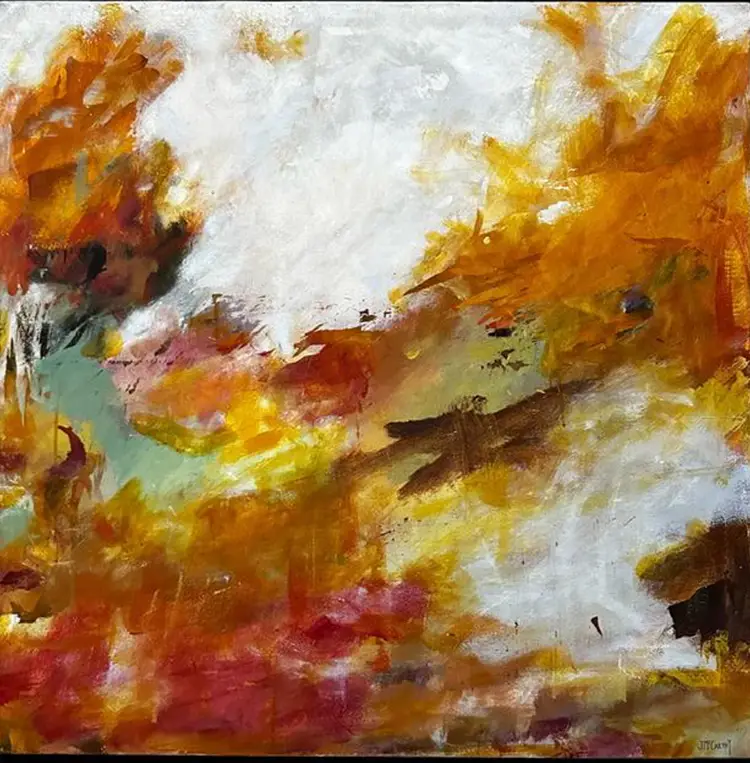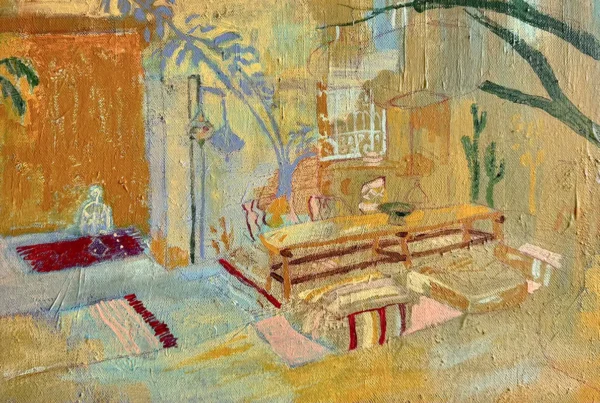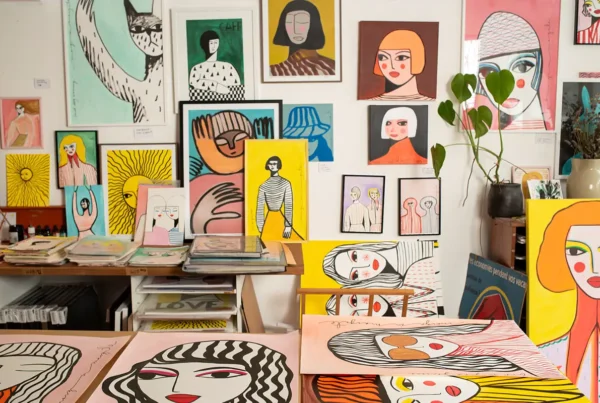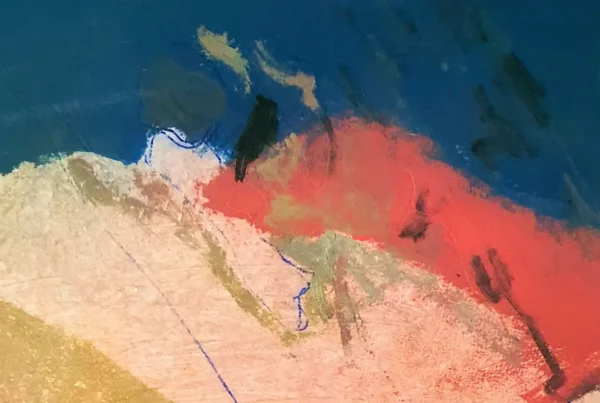“Each painting is really a reflection of some influence that has made it into my every day existence and experience as an artist.”
Unexpected Origins: From Culinary Craft to Abstract Canvas
John McCarthy’s emergence as an abstract painter defies conventional pathways into the visual arts. Based in the Hudson Valley of upstate New York, he originally explored creative expression not through a brush but in the kitchen. Working as a chef, McCarthy turned to painting as a form of decompression, seeking a way to unwind from the intense pace of culinary life. What began as a therapeutic activity soon evolved into a compelling artistic pursuit. As the COVID-19 pandemic brought the hospitality industry to a near standstill, McCarthy found himself painting more frequently and with greater intent, gradually transitioning away from food and into the full-time practice of art. This background continues to shape his visual language; the attention to texture, layering, and composition in his paintings mirrors the careful construction of a well-plated dish, where each element contributes to an overall sensory experience.
McCarthy’s work spans a broad spectrum of emotion and form, encompassing both gestural abstraction and carefully structured compositions. He works across a range of mediums—oil, acrylic, and collage—each offering a unique channel for expression. Acrylics and rice paper frequently feature in his work, where the fluidity of sumi-e ink introduces a sense of rhythm and depth. The result is a fusion of influences: the softness of traditional Japanese aesthetics, the vibrancy of American expressionism, and the intuitive energy of music. Lyrics, melodies, and even individual notes guide his choices of color and movement. The artist doesn’t paint in isolation from the world but allows the visual, auditory, and environmental stimuli around him to flow into his work, transforming each canvas into a kind of synesthetic diary.
Geography plays a profound role in McCarthy’s creative process. His life oscillates between the frenetic pace of New York City and the more contemplative landscapes of the Hudson Valley. These contrasting environments serve as constant sources of inspiration. In the city, angular architecture and muted color palettes introduce a sense of structure and cool precision. In the Hudson Valley, vivid seasonal hues and natural textures invite looser forms and warmer tones. McCarthy finds richness in the interplay between these two extremes, weaving both urban energy and pastoral calm into his pieces. This duality enriches his practice, allowing his paintings to simultaneously express motion and stillness, construction and chaos.
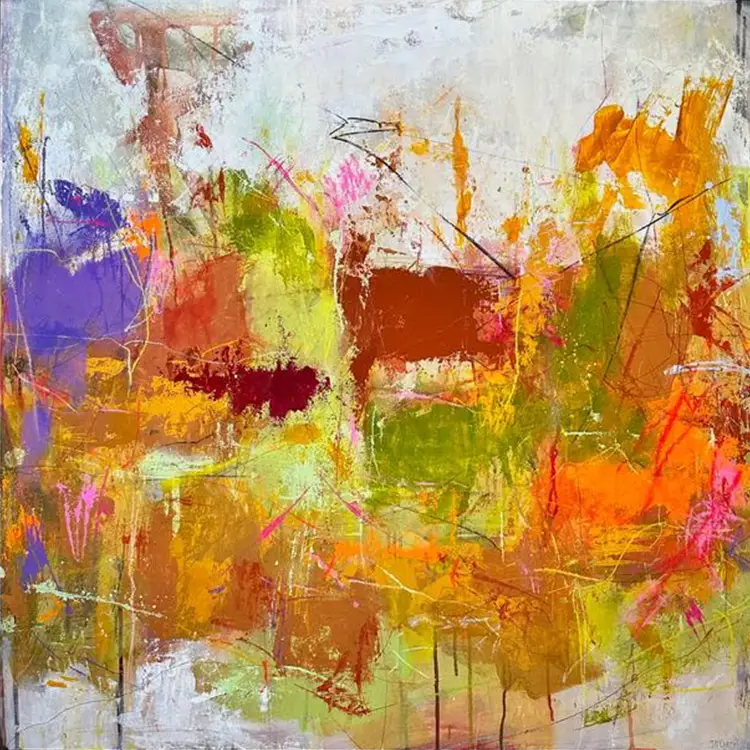
John McCarthy: The Harmony Between Gesture and Grid
McCarthy’s signature style rests in his confident manipulation of paint and texture, where the act of painting becomes a physical, almost performative experience. His brushstrokes often carry the same momentum as a jazz solo or a drumbeat, revealing an emotional immediacy that connects the viewer directly to the artist’s presence in the studio. In many of his acrylic works, thick impasto applications create a sense of movement that feels sculptural rather than purely visual. These textured surfaces invite not just the eye but the imagination to engage with the painting’s physicality. Rather than passively observing, the viewer is pulled into a dialogue with the work’s volume, rhythm, and density.
Yet this raw energy does not tip into chaos. One of the most compelling aspects of McCarthy’s work is his ability to contain spontaneity within subtle frameworks. Several of his pieces employ compositional grids—sometimes explicit, sometimes suggested—that lend a quiet order to the dynamic interplay of color and form. In doing so, McCarthy aligns himself with artists like Gerhard Richter and Cy Twombly, whose abstractions similarly balance wild expressiveness with underlying structure. The juxtaposition of freedom and constraint in McCarthy’s compositions generates visual tension, compelling viewers to pause, reconsider, and re-engage with each piece from multiple perspectives. This interplay echoes the shifting balance of city and countryside that defines his life and surroundings.
Color is more than decoration in McCarthy’s art; it serves as a language of its own. Influenced deeply by Sanzo Wada’s historical Japanese palettes, McCarthy deploys color with an instinctive yet calculated sense of harmony. Earth tones—ochres, russets, deep greens—coexist with brighter, unexpected accents like cyan or violet, creating compositions that are both grounded and electric. These choices often reflect internal states or emotional impressions left by a specific moment, song, or environment. McCarthy’s connection to music becomes particularly evident here: just as a jazz musician might experiment with dissonance or timing, McCarthy explores chromatic contrasts to evoke both familiarity and surprise. Each painting becomes a visual composition, resonating with the fluidity and resonance of sound.
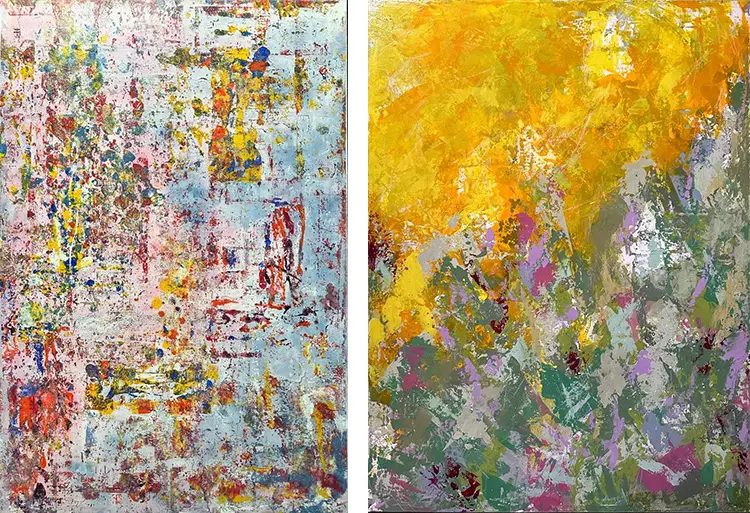
Emotional Traces: The Influence of Memory, Sound, and Setting
Although McCarthy resists singling out any single work as definitive, he attributes profound meaning to the act of artistic exchange itself. He finds significance not in the permanence of the painting, but in the moment it connects with another human being. For McCarthy, the sale of an artwork represents more than a transaction—it is an instance of shared experience, a moment when an internal emotion or fleeting memory is communicated across time and space. This emphasis on human connection reinforces the deeply personal, almost diaristic nature of his art. While certain pieces may stand out to him due to a particular mood or piece of music that accompanied their creation, the true meaning often unfolds in the viewer’s hands.
His process is rooted in daily practice and quiet observation. McCarthy paints as consistently as possible, treating the act of creation not as a performance for an audience but as a necessary, ongoing engagement with his own sensory experiences. His day-to-day surroundings, emotional shifts, and even weather patterns may all influence the choices he makes in his work. This consistency cultivates a body of work that feels both expansive and cohesive, grounded in lived reality rather than conceptual abstraction. Each painting becomes a visual residue of a particular moment, a synthesis of internal reflection and external stimuli. His studio becomes both sanctuary and laboratory, a space where intuition guides technique.
Integral to McCarthy’s work is the influence of Paul Hunter, a sculptor and painter who offered early encouragement and validation. Hunter’s support provided a pivotal affirmation at a formative stage in McCarthy’s journey, reminding him that even modest beginnings could evolve into something significant. This mentorship left a lasting impression, reinforcing the importance of creative community and the power of affirmation. McCarthy’s trajectory was not born of formal art school training, but of persistence, feedback, and the willingness to explore art as a continuous conversation. This openness permeates his practice, where each new canvas is approached as a dialogue—between artist and medium, past and present, viewer and work.
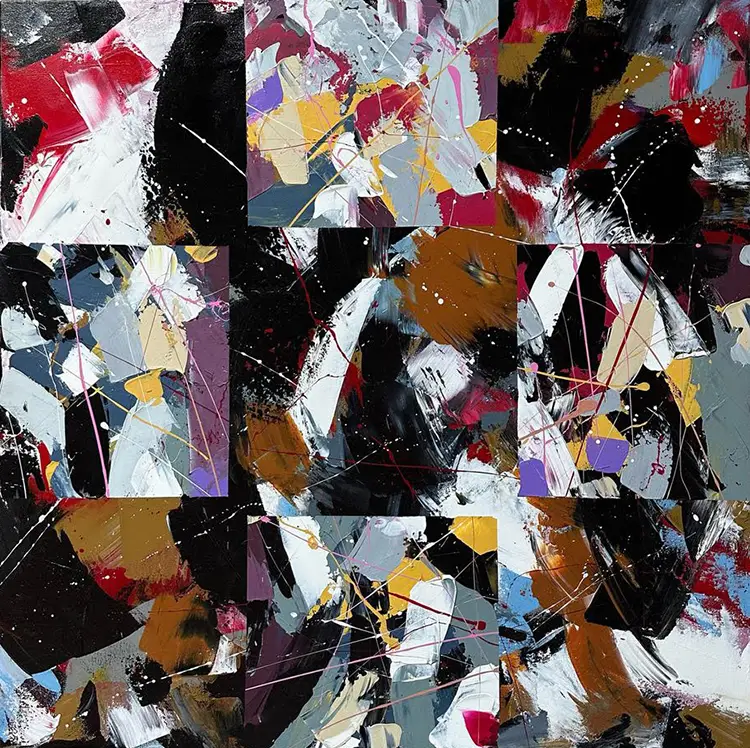
John McCarthy: Movement, Meaning, and Mixed Media
In his most experimental works, McCarthy embraces collage and cultural references to further expand the vocabulary of his practice. These pieces carry a different tone—gritty, direct, and unfiltered. They draw on the visual energy of punk zines and countercultural media, invoking artists like Robert Rauschenberg or Jean-Michel Basquiat. Bold iconography and typographic fragments are layered over gestural brushwork, creating compositions that feel as much like urban walls as they do gallery pieces. Here, paint coexists with printed imagery, found text, and ephemera, shifting McCarthy’s work into a space where fine art and popular culture intersect. This approach underscores his willingness to explore art as both personal expression and societal commentary.
These collage-based works are not mere aesthetic diversions; they reflect the broader scope of McCarthy’s curiosity and the breadth of his references. While his color-rich, abstract paintings may speak to emotional memory or seasonal shifts, these mixed-media compositions tackle ideas rooted in cultural observation. They serve as windows into the artist’s engagement with the world beyond the self, reflecting his awareness of history, iconography, and shifting social narratives. Yet even here, McCarthy’s intuitive sensibility remains central. Rather than delivering a fixed message, these pieces leave space for interpretation, encouraging viewers to find their own entry points into the work.
Looking ahead, McCarthy remains committed to daily painting as both ritual and record. His immediate goal is not tied to a specific exhibition or project, but to the continuation of his creative routine—an ever-evolving journey shaped by sensation, sound, and sight. He views each day in the studio as an opportunity to capture something fleeting: a thought, a mood, a movement in color. Rather than aiming for grand thematic statements, he focuses on presence and observation. Through this attentiveness, his work continues to evolve organically, embracing both the accidental and the deliberate. McCarthy’s future lies not in chasing trends, but in continuing to listen—to music, to his environment, and to the quiet urgings of paint.
